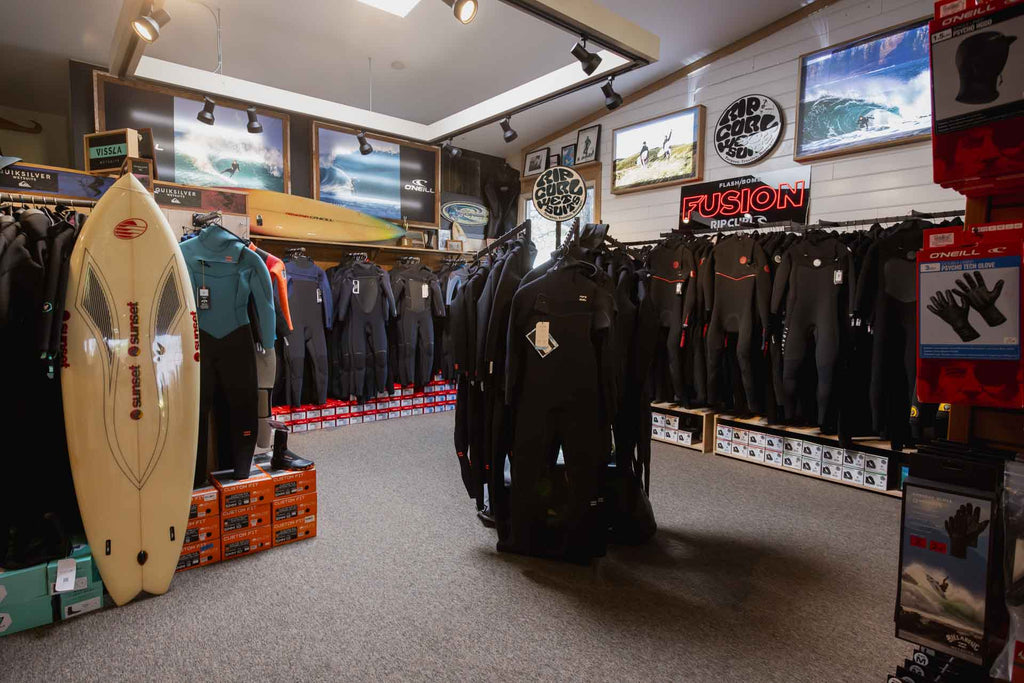Why Read This Guide?
Read this guide if you are looking to purchase your first wetsuit, if it has been a few years since you last bought a wetsuit, or if you simply want to brush up on your wetsuit know-how. Every year or so, wetsuit technology takes a leap forward as new features and materials become available, so it doesn’t hurt to brush up. This guide will be updated regularly to reflect the current wetsuits on the market.
Jump To Chapter
Choosing a Wetsuit
Selecting a wetsuit can seem daunting at times. There are a lot of options out there, and every wetsuit has multiple features that will play a role in its overall warmth, durability, flexibility, and fit. At Cleanline Surf, we stock over 200 unique styles of surf-specific wetsuits. With such a large selection, how do you go about deciding which one will work best for you?
This guide is here to help with that. By the time you’re done reading this guide, you’ll know more about wetsuits than the average surfer, and with this new knowledge, we hope to help you make more informed decisions when buying your new wetsuit. That being said, please keep in mind that this is just a guide, and if you are uncertain about selecting a wetsuit, you can always talk to one of our experts.

A Little About Wetsuits
Wetsuits have been around since the ’50s, and since then, there have been significant technological improvements. We will not go into depth on the history of the wetsuit in this guide, but if you are interested in reading up on the history, here are a few resources.
How Does a Wetsuit Work?
A wetsuit keeps you warm by trapping a thin layer of water between your skin and the neoprene. Your body heats this water up, and your wetsuit prevents the water from leaving the suit and any more water from entering. Neoprene also does a great job blocking wind, so any wind chill factor is cut down significantly.
What Makes a Surfing Wetsuit Different From Dive Suits?
Wetsuits made specifically for surfing have many unique qualities that make them different than scuba wetsuits. Generally, surfing wetsuits are much lighter and more flexible, especially in the arms and shoulders, compared to dive suits. Wetsuits also have specialized chest and back panels to block wind and keep a surfer’s cores warm when sitting on their board above water. The neoprene in surfing wetsuits is also different than the neoprene used for scuba diving: dive suits are designed to withstand the continuous compression and re-expansion caused by the extreme pressure of being deep underwater for extended periods of time.
What Makes a Surfing Wetsuit Different From Triathlon Suits?
Triathlon wetsuits use a smooth skin material to make them more hydrodynamic. They are also built for speed and are not usually as durable as surf wetsuits.
What is the Difference Between a Surfing Wetsuit and a Drysuit?
Wetsuits are completely different than drysuits, and if you are surfing, you definitely want a wetsuit, not a drysuit. The biggest (and somewhat obvious) difference is that wetsuits do not keep you dry, while drysuits do. Other than that, wetsuits are formfitting and make it easier to duck dive under waves. If you tried paddling out with a drysuit, you would have a lot of drag, and it would be much more difficult than it would be in a wetsuit.
The Four Key Attributes

There are four key attributes to consider when selecting the right wetsuit: Warmth, Flexibility, Durability, and Fit. Balancing these four attributes makes the perfect wetsuit. Some aspects will take from another, for example if you add materials like seam tape to a wetsuit, it will become more durable but at the cost of becoming less flexible. Other features may factor in as well, such as built-in hoods, different zipper types, overall weight of the suit, key stash pockets, color, price, and more.
Four Things to Look for in a Wetsuit
Flexibility
Flexibility is essentially how stretchy a suit is. You’ll need a really flexible wetsuit in order to paddle with ease, perform more advanced maneuvers, and get in and out of the wetsuit without the help from a friend. The biggest factor that affects flexibility is the thickness of the neoprene. Assuming the same type of neoprene is used, the thicker the suit the less flexible it is going to be, so if you are used to wearing a 3/2 and then you go on a trip to a place where you need a 5/4/3 you will find it a lot more resistant to your movement.
Warmth
The number one reason you need a wetsuit is to stay warm. If you aren’t warm out in the water, then what’s the point? The warmth of a wetsuit is most directly related to the thickness of the neoprene used. The thicker the neoprene is, the warmer it will be. Other factors to consider are seam construction, internal linings, entry systems, and type of neoprene.
Durability
Ensuring your wetsuit is going to last is key. Generally, the seams of a wetsuit are the weakest point, so the best way to determine the durability of a wetsuit is by the seam construction. There are many ways to reinforce seams on a wetsuit, which will be covered in this guide in the Seam Construction chapter.
Fit
Not to be overlooked; fit could easily be considered the most important factor when selecting a wetsuit. If your wetsuit doesn’t fit properly, it won’t keep you warm, and it can be very uncomfortable. Getting this right can be challenging and frustrating, but it can also be a workout or an easy learning experience. We’ll go in-depth on wetsuit fitting later in this guide.

What Our Customers Are Saying